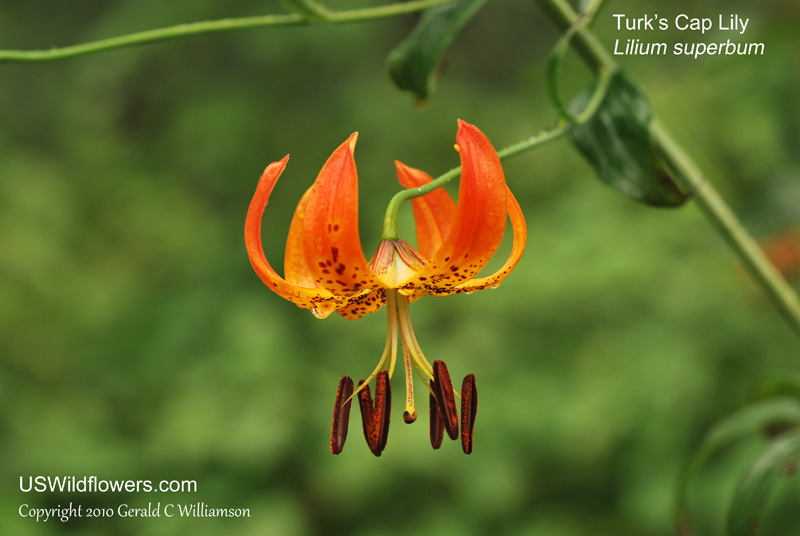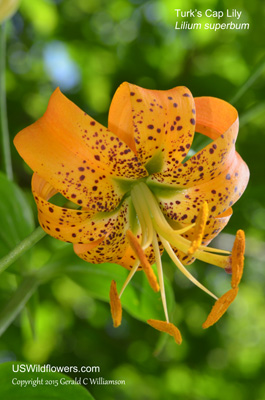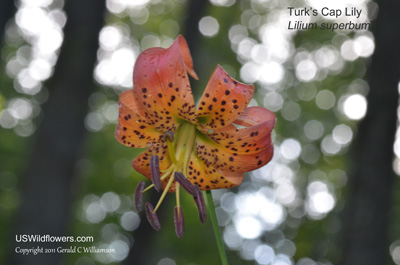Turk's Cap Lily, Turban Lily, Lily Royal, Swamp Lily, American Tiger Lily - Lilium superbum
|
Lilium superbum - Turk's Cap Lily, Turban Lily, Lily Royal, Swamp Lily, American Tiger Lily. Of the 100 or so species of Lilium worldwide, about 22 are found in North America. Of those 22, over half have pendent flowers - their pedicels curve around downward, and the flower hang toward the ground like pendants. Turk's Cap Lily - Lilium superbum - is one of those pendent lilies. The common name Turks Cap comes from the shape of the perianth, with tepals (or petals and sepals) strongly reflexed, giving it somewhat the shape of the bulbous turbans worn by some Turks in ages past -  . .
Lilium superbum is Fairly widely distributed, being found in most states east of the Mississippi River, as well as in Arkansas and Missouri. Within its range, there are several similar pendent Lilium species, including L. michauxii (Carolina Lily) and L. michiganense (Michigan Lily.) L. superbum is the largest of the native pendent lilies; other differentiating diagnostics are noted along with the photos below.
Found in:
AL, AR, CT, DC, DE, FL, GA, IL, IN, KY, MA, MD, MN, MS, NC, NH, NJ, NY, OH, PA, RI, TN, VA, WV
Leave comments on Lilium superbum at this link. | 
Distribution of Lilium superbum in the United States and Canada:

Map courtesy of The Biota of North America Program.
Map color key
Search Our Database: Enter any portion of the Scientific, Common Name, or both.
Do a general Google search of the entire site:
#ad
 Follow USWildflowers on Twitter
#ad
| | Site: Blue Ridge Parkway, Haywood County, NC Date: 2010-July-12 | Photographer: Gerald C. Williamson
Nikon D60
Tamron SP 90MM f/2.8 AF Macro | | L. superbum (shown here), L. michauxii, and L. michganense all have strongly reflexed tepals (although usually more reflexed than in this photo; the flower must be early in its life-cycle.) They bend back above the perianth in L. superbum and L. michauxii, whereas in L. michaganense they reflex back to the base of the perianth. The style of L. superbum and L. michauxii is pale, and sometimes spotted purple, as in this photo. That style of L. michiganense is reddish or the color of the tepals, either in the entire length or at least in a significant portion of the tip (distal end.) Unlike the other two, L. michauxii is sweetly fragrant - it is the only fragrant native Lilium east of the Rockies. | | 
| | Site: Great Smoky Mountains National Park, Clingman's Dome Road, Swain County, NC Date: 2015-July-16 | Photographer: Gerald C Williamson
Nikon D7000 | | One key diagnostic for L. superbum is the green star formed by the bases of the tepals; this is not present in any other pendent Lily. However, I have read some descriptions indicating that the green star may occasionally be absent in L. superbum. The stamens and style are exserted well beyond the recurved tepals, as is also the case with L. michauxii and L. michiganense. The filaments of each are parallel at first, and then spread widely, but those of L. michiganense may spread earlier than those of the other two species. The style is pale green in L. superbum, reddish or the color of the tepals in L. michiganense. | | Click on the photo for a larger image

| | Site: Blue Ridge Parkway, Haywood County, NC Date: 2011-August-01 | Photographer: Gerald C Williamson
Nikon D7000
Tamron SP 90MM f/2.8 AF Macro | | Turk's Cap Lily's tepals are usually yellow-orange at the base (above the green marking), and transition to red-orange toward the tip. Like L. michauxii and L. michiganense they have purple or burgundy spots. L. michiganense is different from the other two in that it is missing the parallel ridges on the back of the sepals that can be seen in this photo (if you look closely!) | | Click on the photo for a larger image

| | Site: Great Smoky Mountains National Park, Clingman's Dome Road, Swain County, NC Date: 2015-July-16 | Photographer: Gerald C Williamson
Nikon D7000 | | The Turk's Cap Lily inflorescence is a raceme of usually 3 to 25 flowers. That of L. michiganense is also a raceme - the pedicels are attached to the central stem at indeterminate points - but with fewer flowers, rarely more than 11. The inflorescence of L. michauxii is an umbel - all pedicels are attached at a central point - and usually will have no more than 4 flowers. | | Click on the photo for a larger image

| | Site: Blue Ridge Parkway, Haywood County, NC Date: 2011-August-01 | Photographer: Gerald C Williamson
Nikon D7000
Tamron SP 90MM f/2.8 AF Macro | | The leaves of all three Lilium species being discussed here are in whorls, but L. superbum, shown here, is a taller plant (up to 8 feet tall), and will have from 6 to 24 whorls of 3 to 20 leaves - a much leafier plant than the other two. L. michiganense is also a tall plant, growing to 7 feet, while L. michauxii (Carolina Lily) usually does not exceed 4 feet in height. The 4 to 12 leaf whorls of Michigan Lily have 5 to 20 leaves, while the shorter leaves of Carolina Lily usually are in 2 to 4 whorls of 3 to 7 leaves. In all cases the upper leaves may be alternate rather than whorled. While it's not unusual for Carolina Lily to have a single flower, that can occasionally also be the case for both Michigan Lily and, as shown here, for Turk's Cap Lily as well. While rarely having more than 25 flowers, there are reports of as many as 40 flowers on a Turk's Cap Lily plant. | | Click on the photo for a larger image

| | Site: Blue Ridge Parkway, Haywood County, NC Date: 2010-July-12 | Photographer: Gerald C Williamson
Nikon D60 | | The usually dull purple anthers of Turk's Cap Lily have rust-colored pollen. They are more than .5-inch and up to over 1 inch long, similar to those of Carolina Lily (although these are usually smaller.) The anthers of Michigan Lily are rarely more than .5 inch long. | | Click on the photo for a larger image

|
References used for identification and information:
|
|
| |
| #ad
|
|
 .
.








